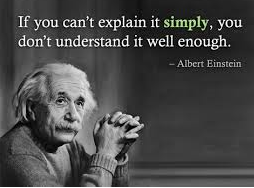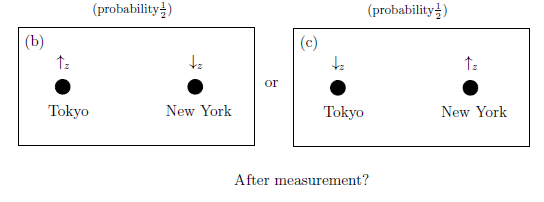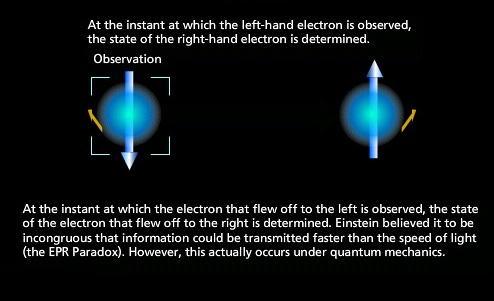
$\S$4.4.1: EPR-paradox
Let us explain EPR-paradox (Einstein--Poolside--Rosen). Consider Two electrons $P_1$ and $P_2$ and their spins. Thetensor Hilbert space $H={\mathbb C}^2 \otimes {\mathbb C}^2$ is defined in what follows. That is,
\begin{align}
e_1=
\left[\begin{array}{l}
1 \\
0
\end{array}\right],
\quad
e_2
=
\left[\begin{array}{l}
0 \\
1
\end{array}\right]
\end{align}
(i.e., the complete orthonormal system $\{ e_1, e_2 \}$ in the ${\mathbb C}^2$),
\begin{align}
{\mathbb C}^2 \otimes {\mathbb C}^2
=
\{
\sum\limits_{i,j=1,2} \alpha_{ij} e_i \otimes e_j
\;|\;
\alpha_{ij}
\in {\mathbb C},
i,j=1,2
\}
\end{align}
Put $u=\sum\limits_{i,j=1,2} \alpha_{ij} e_i \otimes e_j$ and $v=\sum\limits_{i,j=1,2} \beta_{ij} e_i \otimes e_j$. And the inner product $\langle u,v \rangle_{_{{\mathbb C}^2 \otimes {\mathbb C}^2}}$ is defined by
\begin{align}
\langle u,v \rangle_{_{{\mathbb C}^2 \otimes {\mathbb C}^2}}
=
\sum\limits_{i,j=1,2} \overline{\alpha}_{i,j}\cdot \beta_{i,j}
\end{align}
Therefore, we have the tensor Hilbert space $H={\mathbb C}^2 \otimes {\mathbb C}^2$ with the complete orthonormal system $\{ e_1 \otimes e_1,
e_1 \otimes e_2,
e_2 \otimes e_1,
e_2 \otimes e_2
\}$.
For each $F\in B({\mathbb C}^2)$ and $G\in B({\mathbb C}^2)$, define the $F\otimes G \in B({\mathbb C}^2 \otimes {\mathbb C}^2)$ (i.e., linear operator $F\otimes G : {\mathbb C}^2 \otimes {\mathbb C}^2 \to {\mathbb C}^2 \otimes {\mathbb C}^2$ ) such that
\begin{align}
(F \otimes G) ( u \otimes v) = Fu \otimes Gv
\end{align}
Let us define the entangled state $
\rho = |s \rangle \langle s |
$ of two particles $P_1$ and $P_2$ such that
\begin{align}
s=
\frac{1}{\sqrt 2} (e_1\otimes e_2 - e_2 \otimes e_1 )
\end{align}
Here, we see that $\langle s,s \rangle_{_{{\mathbb C}^2 \otimes {\mathbb C}^2}}$ $=\frac{1}{2}\langle e_1\otimes e_2 - e_2 \otimes e_1 ,e_1\otimes e_2 - e_2 \otimes e_1 \rangle_{_{{\mathbb C}^2 \otimes {\mathbb C}^2}}$ $=\frac{1}{2}(1+1)=1$, and thus, $\rho$ is a state. Also, assume that
two particles $P_1$ and $P_2$ are far.
Let ${\mathsf O} =(X,2^X, F^z )$ in $B({\mathbb C}^2)$ (where $X=\{\uparrow ,\downarrow \}$ ) be the spin observable concerning the $z$-axis such that
\begin{align}
F^z( \{ \uparrow \})
=
\left[\begin{array}{lL}
1 & 0 \\
0 & 0
\end{array}\right]
\quad
F^z( \{ \downarrow \})
=
\left[\begin{array}{ll}
0 & 0 \\
0 & 1
\end{array}\right]
\end{align}
The parallel observable ${\mathsf O}\otimes {\mathsf O} =(X^2,2^X\times 2^X, F^z \otimes F^z)$ in $B({\mathbb C}^2\otimes {\mathbb C}^2)$ is defined by
\begin{align}
&
(F^z \otimes F^z)(\{(\uparrow,\uparrow )\})=F^z(\{\uparrow \}) \otimes F^z(\{\uparrow \})
=
\left[\begin{array}{ll}
1 & 0 \\
0 & 0
\end{array}\right]
\otimes
\left[\begin{array}{ll}
1 & 0 \\
0 & 0
\end{array}\right]
\;\;
\\
&
(F^z \otimes F^z)(\{(\downarrow,\uparrow )\})=F^z(\{\downarrow \}) \otimes F^z(\{\uparrow \})
=
\left[\begin{array}{ll}
0 & 0 \\
0 & 1
\end{array}\right]
\otimes
\left[\begin{array}{ll}
1 & 0 \\
0 & 0
\end{array}\right]
\\
&
(F^z \otimes F^z)(\{(\uparrow,\downarrow )\})=F^z(\{\uparrow \}) \otimes F^z(\{\downarrow \})
=
\left[\begin{array}{ll}
1 & 0 \\
0 & 0
\end{array}\right]
\otimes
\left[\begin{array}{ll}
0 & 0 \\
0 & 1
\end{array}\right]
\;\;\\
&
(F^z \otimes F^z)(\{(\downarrow,\downarrow )\})=F^z(\{\downarrow \}) \otimes F^z(\{\downarrow \})
=
\left[\begin{array}{ll}
0 & 0 \\
0 & 1
\end{array}\right]
\otimes
\left[\begin{array}{ll}
0 & 0 \\
0 & 1
\end{array}\right]
\end{align}
Thus, we get the measurement ${\mathsf M}_{B({\mathbb C}^2\otimes {\mathbb C}^2)}({\mathsf O}\otimes {\mathsf O},S_{[\rho]})$ Then, Born's quantum measurement theory says that
| $\bullet$ | When the parallel measurement ${\mathsf M}_{B({\mathbb C}^2\otimes {\mathbb C}^2)}({\mathsf O}\otimes {\mathsf O},S_{[s]})$ is taken,
the probability that the measured value $
\left[\begin{array}{ll}
(\uparrow,\uparrow )
\\
(\downarrow,\uparrow )
\\
(\uparrow,\downarrow )
\\
(\downarrow,\downarrow )
\end{array}\right]
$ is obtained is given by
\begin{align}
\left[\begin{array}{ll}
\langle s,
(F^z \otimes F^z)(\{(\uparrow,\uparrow )\})s
\rangle_{_{{\mathbb C}^2 \otimes {\mathbb C}^2}}
=
0
\\
\langle s,
(F^z \otimes F^z)(\{(\downarrow,\uparrow )\})s
\rangle_{_{{\mathbb C}^2 \otimes {\mathbb C}^2}}
=
0.5
\\
\langle s,
(F^z \otimes F^z)(\{(\uparrow,\downarrow )\})s
\rangle_{_{{\mathbb C}^2 \otimes {\mathbb C}^2}}
=
0.5
\\
\langle s,
(F^z \otimes F^z)(\{(\downarrow,\downarrow )\})s
\rangle_{_{{\mathbb C}^2 \otimes {\mathbb C}^2}}
=
0
\end{array}\right]
\tag{4.46}
\end{align}
|
That is because, $F^z (\{\uparrow \})e_1=e_1$, $F^z (\{\downarrow \})e_2=e_2,F^z (\{\uparrow \})e_2= F^z (\{\downarrow \})e_1=0$ For example,
\begin{align}
&
\langle s,
(F^z \otimes F^z)(\{(\uparrow,\downarrow )\})s
\rangle_{_{{\mathbb C}^2 \otimes {\mathbb C}^2}}
\\
=
&
\frac{1}{2}\langle
(e_1\otimes e_2 - e_2 \otimes e_1 )
,
(F^z(\{\uparrow \}) \otimes F^z(\{\downarrow \})
(e_1\otimes e_2 - e_2 \otimes e_1 )
\rangle_{_{{\mathbb C}^2 \otimes {\mathbb C}^2}}
\\
=
&
\frac{1}{2}\langle
(e_1\otimes e_2 - e_2 \otimes e_1 )
,
e_1\otimes e_2
\rangle_{_{{\mathbb C}^2 \otimes {\mathbb C}^2}}
=
\frac{1}{2}
\end{align}
Here, it should be noted that we can assume that the $x_1$ and the $x_2$ (in $(x_1, x_2)$ $ \in $ $\{$ $
(\uparrow _{z},\uparrow _{z}),$ $
(\uparrow _{z},\downarrow _{z}),$ $
(\downarrow _{z},\uparrow _{z}),
(\downarrow _{z},\downarrow _{z})
\}$) are respectively obtained in Tokyo and in New York (or, in the earth and in the polar star).

 This fact is, figuratively speaking, explained as follows:
This fact is, figuratively speaking, explained as follows:
| $\bullet$ | Immediately after the particle (or, wavefunction) in Tokyo is measured and the measured value $\uparrow _{z}$ [resp. $\downarrow _{z}$] is observed, the particle (or, wavefunction) in Tokyo informs the particle (or, wavefunction) in New York " Your measured value has to be $\downarrow _{z}$ [resp. $\uparrow _{z}$]"$\!\!\!\!.\; \;$
|
Therefore, the above fact implies that quantum mechanics says that
\begin{align}
\mbox{there is something faster than light.}
\end{align}
This is essentially the same as the de Broglie paradox. That is,
| $\bullet$ | if we admit quantum mechanics, we must also admit the fact that there is
something faster than light (i.e., so called "non-locality").
|
| $\fbox{Note 4.4}$ | EPR-paradox is closely related to the fact that quantum syllogism does not hold in general. This will be discussed in Chapter 8.
The Bohr-Einstein debates were a series of public disputes about quantum mechanics between Albert Einstein and Niels Bohr. Although Bohr may assert that his Copenhagen interpretation belongs to physics, I want to regard this debates as
\begin{align}
\underset{\mbox{ (realistic view)}}{\fbox{$\mbox{Einstein}$}}
\quad
\underset{\mbox{v.s.}}{\longleftrightarrow}
\quad
\underset{\mbox{ (linguistic view)}}{\fbox{$\mbox{Bohr}$}}
\end{align}
For the further argument, see Section 10.7 (Leibniz-Clarke debates). I want to believe that the grand debates in science should be always "realistic view vs. linguistic view".
|


 This fact is, figuratively speaking, explained as follows:
This fact is, figuratively speaking, explained as follows:
